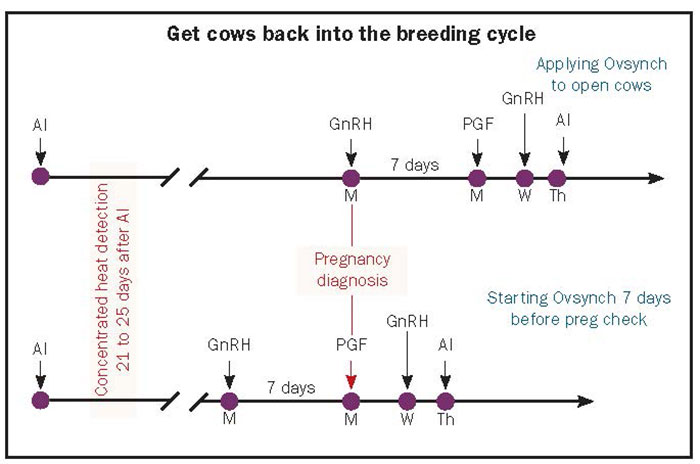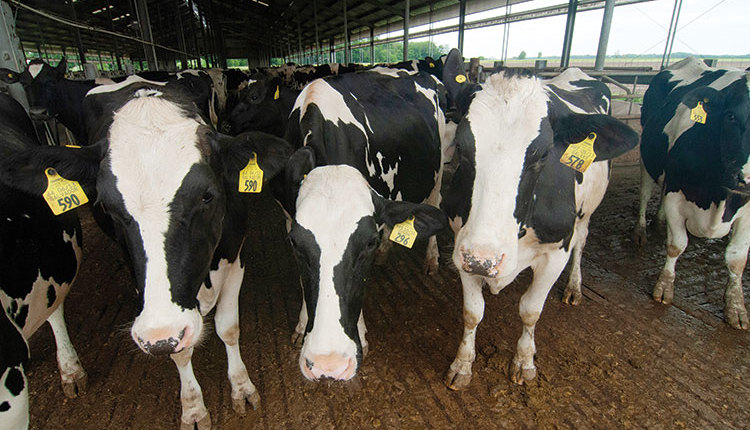Not everyone likes Mondays. I do because it is preg check day at our Kansas State Dairy. It is the culmination of a lot of effort made by everyone on the dairy farm. It is a time to relish successes and evaluate failures.
For many years, my students and I have conducted pregnancy diagnosis every Monday morning. We use ultrasound to assess pregnancy status of cows and heifers inseminated between 30 and 36 days earlier, with the exception of those that were reinseminated during the interim. It gives me an opportunity to teach my students and also conduct various research projects with the identified nonpregnant cows.
Let’s ask some obvious questions about that pregnancy diagnosis. What is the value of pregnancy diagnosis? How often should it be done? What tools do we have to accomplish the task?
Breeding is like hunting
To seasonal grazing dairy producers, who have abbreviated breeding seasons, urgency on their part is to get as many cows pregnant as possible in 60 to 90 days. Although most conventional dairies have a 365-day breeding season, urgency is still needed.
Breeding cows is a lot like hunting. We track the right cows, scope out the best way to treat them, trigger the program to prepare them for breeding, and then execute the plan.
Without the presence of a bull, breeding cows is a 24/7 job. Thus, the challenge is finding our target in a timely manner. Although we get satisfaction in calling a heifer or cow pregnant, the greatest value derived from pregnancy diagnosis is identifying those that are still not pregnant.

How often should we hunt?
It is not uncommon for smaller-size dairies to conduct pregnancy diagnosis less than once a week. Partly because so few cows are eligible or, in some cases, because the veterinary practitioner travels extensively to service the herd. Less than weekly pregnancy diagnosis in the absence of perfect heat detection translates into cows staying open for long periods of time, creating greater inter-insemination intervals.
When a veterinary practitioner is not available on a weekly basis, you can always use the PAG test (pregnancy-associated glycoprotein) and have results back within a few days. For more details, see “When is the optimal time to run new-age preg tests?” Hoard’s Dairyman, November 2015, page 726.
Most of the standard rebreeding or resynch programs tie in nicely with weekly preg checks. It allows one to start the open cow in a resynch program by administrating GnRH or to culminate the resynch program with an injection of prostaglandin if all cows had received GnRH one week earlier when pregnancy status was yet unknown. These options are illustrated in the figure.
Another important point is the effort that should be made to identify open cows as they come back into heat in the 21 to 25 day window after a previous insemination. Good heat detection that may include heat mount patches, tail or chalk paint removal, activity monitors, and visual observation is essential to reduce the number of open cows identified at each pregnancy diagnosis. Every effort made to lower the inter-insemination interval will result in getting cows pregnant in a more timely fashion.
Another point to be made about frequency is the number of times the pregnant cow is retested to ensure the pregnancy has not been aborted. Test for pregnancy as early as possible and reconfirm that pregnancy several times. We verify the first positive diagnosis about four to six weeks later and again later in gestation before dry-off.
Measure the hunt’s success
A number of measures are often used to assess the success of the breeding program. These include: days open, calving interval, conception rate, 21-day pregnancy rate, and heat detection rate.
Which measures are more reliable?
Days open and calving interval are good measures but they can be misleading because they are highly influenced by culling rate. If most of the problem breeding cows are routinely sold, days open and calving intervals hide some real underlying breeding problems.
Conception rate also can be misleading. One can achieve 50 percent conception in all cows that are inseminated, but if you are missing a lot of cows in heat (poor heat detection), the overall number of pregnancies achieved will not be very high.
Although heat detection rate is usually a good measure because it determines the A.I. submission rate or the proportion of all cows being inseminated, the 21-day pregnancy rate is one of the best measures of success. Pregnancy rate combines both heat detection and conception rates. By definition, it is the proportion of breeding-eligible cows in the herd that become pregnant every 21 days. Therefore, it includes heat detection and fertility into one standard measure.
Pregnancy or open diagnosis is a tool that should be used as early as possible to ensure your cows have greater chances of staying in your herd for many lactations. Cow longevity and more milk production from the mature cows contribute big dividends to your revenue and pride in herd ownership. Happy A.I. breeding!







